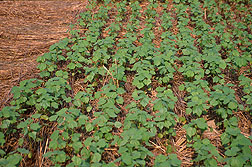This page has been archived and is being provided for reference purposes only. The page is no longer being updated, and therefore, links on the page may be invalid.
Compacting Cotton Rows Could Be More EconomicalBy Tara Weaver-MissickJanuary 5, 2000 Research is underway at Agricultural Research Service locations to make ultra narrow row (UNR) cotton production more economical for farmers. ARS is the chief research agency of the U.S. Department of Agriculture. For more than a century, farmers have planted cotton in wide rows with up to 40 inches between them. The rows had to be wide enough for a mule-driven plow to maneuver, so the animal wouldn’t trample the crop. With UNR, cotton is planted in rows that range from about 7-1/2 to 10 inches wide. A farmer can plant more rows and potentially yield more cotton per acre, says William T. Molin, a plant physiologist with ARS’ Southern Weed Science Unit in Stoneville, Miss. Also, since rows are planted closer together, cotton crowds the weeds out, reducing the need for mid-season herbicide applications. Molin and other ARS researchers are participating in a 10-year project looking at varying aspects of long-term UNR cotton production--from managing weeds to processing. There’s not enough solid information on UNR cotton available to farmers. In 1998, Molin began field studies on 40-acres to compare UNR with conventional cotton. He grew 12 popular varieties using both wide and narrow rows. Results showed UNR cotton was comparable in yield to conventional wide-row cotton. An in-depth article on ultra narrow row cotton research appears in the January issue of Agricultural Research magazine. Scientific contact: William T. Molin, ARS Southern Weed Science Research Unit, Stoneville, Miss.,phone (601) 686-5245, fax 601) 686-5422, wmolin@ag.gov. |

